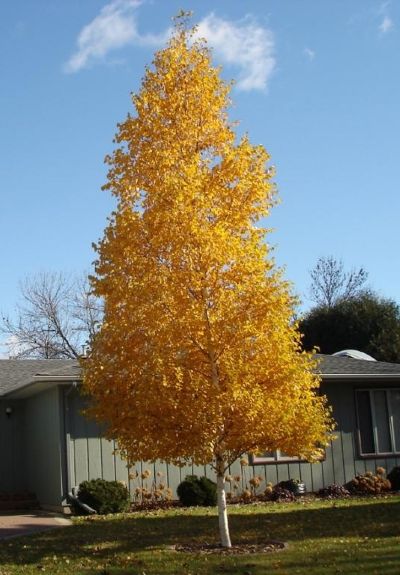Dakota Pinnacle® Asian White Birch - Betula platyphylla ‘Fargo' (RFM-19)


Description:
Selected for its narrow columnar to narrowly pyramidal growth habit. Hardier than the species with dense dark green foliage that turns golden yellow in the fall. The bark is white and smooth with slight exfoliation when mature. Dakota Pinnacle® is drought tolerant and has above average tolerance to bronze birch borer and strong winds.
Hardiness:
USDA hardiness zone 3a-7
Mature Size:
Height: 35', Spread: 10-12'
Form (Shape):
Upright columnar
Growth Rate:
Medium - Fast
Foliage:
Foliage is dark green during the summer. In autumn, leaves are a golden yellow, retained until late.
Texture:
Fine - Medium
Flower:
Flowers/fruit are not ornamentally significant.
Special Feature:
Columnar habit of growth, 10 year-old tree is 30’ tall and 8’ wide. Bark color goes through a transitional phase from grayish-orange on 3-year-old stems, orange-white on 6-year-old stems to yellow-white on mature trunks.
Light Preferences:
Full sun to partial shade
Soil Preferences:
It is very adaptable to both dry and moist locations. It is not particular as to soil type or pH. It is highly tolerant of urban pollution and will thrive in inner city environments.
Propagation:
Tissue culture, grafting and/or softwood cuttings.
Ornamental Attributes:
Dakota Pinnacle® has dark green foliage throughout the season. The smooth white bark is extremely showy and adds significant winter interest.
Landscape Attributes:
Deer resistant. Dakota Pinnacle® is recommended for vertical accent elements or specimen tree. It is recommended that trees be mulched and supplementary water supplied in stressful sites. Mulch will assist with winter protection in exposed locations or colder zones.
Patent Status:
- U.S. Trademark registered Dakota Pinnacle®
- U.S. Plant Patent No. 10,963
- Canadian Trademark registered
Licensing Status:
This cultivar is available for non-exclusive licensing.
Download
PDF Datasheet
Inquire about this technology >